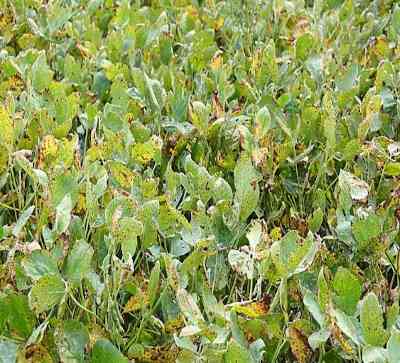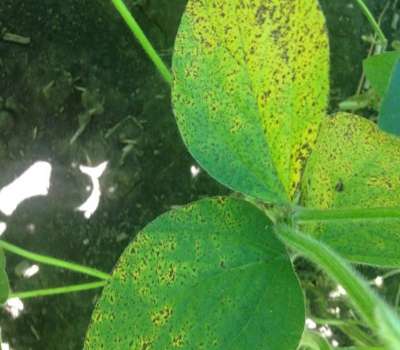By Emmanuel Byamukama
Soybean leaf diseases such as frogeye leaf spot, brown/Septoria spot, and Cercospora leaf blight, can develop, in some soybean fields, to reach yield-reducing levels. Severe frogeye leaf spot (Figure 1) or brown spot (Figure 2) can lead to premature leaf drop.
The best timing for foliar fungicide application to manage these diseases is the R3-R4 (beginning pod to full pod) growth stages. The question that growers often ask is whether it is profitable to apply a fungicide to soybeans at the R3/R4 growth stage in South Dakota.
The short answer is the return on the fungicide investment for controlling foliar diseases depends on the fungal disease pressure observed on the plants at the R3/R4 growth stage.

Figure 1. A soybean field with heavy frogeye leaf spot infection. Premature defoliation will occur in plants with high levels of this disease.
Fungicide Efficacy
Several fungicide efficacy reports indicate that there is a limited benefit to applying fungicides in soybean in South Dakota primarily due to low disease pressure.

Figure 2. A soybean plant with heavy brown spot severity on mid-lower canopy.
Our small plot research trials looked at several products and did not detect significant statistical differences. The highest disease pressure (assessed 21 days after product application) was less than 2% (Table 1). Similarly, on-farm fungicide strip trials (field-length side by side trials) also showed mostly non-significant differences between fungicide treated strips and non-treated strips (no fungicide applied). Out of 11 on-farm strip trials in 2019, only 2 had a positive return to fungicide application.
Visit the South Dakota Soybean On-Farm Research Program’s trials website for the on-farm trial results on fungicides and other practices conducted by Professor David Clay’s group.
TABLE 1. EFFECT OF FUNGICIDE APPLICATION ON SOYBEAN DISEASE SEVERITY AND GRAIN YIELD. FUNGICIDE APPLICATION DID NOT HAVE A SIGNIFICANT EFFECT ON YIELD COMPARED TO NON-TREATED PLOTS.
| Treatment/Rate/Timing | Brown spot (%) | Frogeye leaf spot (%) | Yield (bu/ac) |
|---|
| Non-treated check | 0.30 a | 0.83 a | 52.06 a |
| Priaxor, 8fl oz/A@R3 | 0.45 a | 1.80 a | 58.73 a |
| Fortix, 4fl oz/A@R3 | 0.33 a | 1.43 a | 56.44 a |
| Sonata, 1qt/A@R3 | 0.08 a | 1.73 a | 53.85 a |
| Domark 230ME, 4fl oz/A@R3 | 0.28 a | 1.68 a | 50.94 a |
| Trivapro 10fl oz/A@R3 | 0.13 a | 1.28 a | 57.57 a |
| Zolera FX 3.34SC, 5fl oz/A@R3 | 0.43 a | 1.28 a | 50.74 a |
| Delaro, 8fl oz/A@R3 | 0.15 a | 1.13 a | 59.96 a |
Application Considerations
Both the small plots research and on farm trials indicate that a decision to apply a fungicide to control mid- to late-season soybean diseases should be based on the likelihood for foliar diseases to develop. This can be determined by considering field disease history, susceptibility of the cultivar planted, type and level of diseases already developing, and weather conditions.
Of the leaf diseases which can develop late in season in soybeans, frogeye leaf spot is the most important and can result in significant yield losses. Moreover, the frogeye leaf spot pathogen has been found to be resistant to strobilurin fungicides (QoI, FRAC Code 11) in several fields in South Dakota. What this means for fields with frogeye pathogen isolates resistant to QoIs, applying these fungicides will be like applying water, the fungus will not be affected. To avoid further development of more frogeye leaf spot pathogen isolates with QoI resistance, these fungicides should not be applied in fields with moderate levels of frogeye leaf spot. Other modes, like triazoles or SDHI fungicides, should be used instead.
If a fungicide is determined to be needed, there are a number of fungicides available on the market which are effective against the common foliar diseases in soybeans. An efficacy table developed by Plant Pathologists in the Northcentral Region provides information on which products to use for various soybean diseases.
Source : sdstate.edu